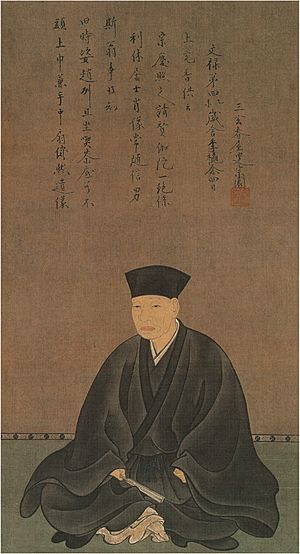Schools of Japanese tea facts for kids

"Schools of Japanese tea" are the different ways or "styles" of the Japanese tea ceremony. In Japanese, these styles are called ryūha.
The Three Sen Families (San-Senke)
There are three main families that have kept alive and taught the special tea ceremony style created by Sen no Rikyū. He was a famous tea master from the 1500s. These families are directly related to him. They are known together as the "three Sen houses" or san-Senke. These are the Omotesenke, Urasenke, and Mushakōjisenke tea schools.
The san-Senke started because three of Sen no Rikyū's grandson's sons each took over or built a tea house. They promised to continue their great-grandfather's tea ideas and methods.
- Kōshin Sōsa took over the Fushin-an tea house. He became the head, or iemoto, of the Omotesenke family.
- Sensō Sōshitsu took over the Konnichi-an tea house. He became the iemoto of the Urasenke family.
- Ichiō Sōshu built the Kankyū-an tea house. He became the iemoto of the Mushakōjisenke family.
The names of these families come from where their tea houses were located. "Omote" means "front," "ura" means "rear," and Mushakōji is a street name.
The tea ceremony style that Sen no Rikyū perfected is called wabi-cha. It focuses on simplicity and quiet beauty. The san-Senke families have always supported and taught this style of tea.
Other tea schools that grew from the san-Senke, or started separately, often have "~ryū" at the end of their names. This means "school" or "style."
Warrior Household Tea (Buke-cha)
Besides wabi-cha, there's another tea ceremony style called buke-cha. This means "warrior household tea." It's also known as daimyo-cha, which refers to the tea style practiced by powerful warrior lords called daimyo. This style was popular mostly during the Edo period in Japan.
Often, a daimyo would choose an official tea style for his area. Tea teachers would then teach this style. Some daimyo were also very skilled tea masters themselves.
Some of the main buke-cha styles include Uraku, Sansai, Oribe, Enshū, Ueda Sōko, and Sekishū. The Sekishū school became very popular among warriors. Its founder was a tea teacher for the shōgun, who was the military ruler of Japan.
Some Current Tea Schools
Here are a few of the many tea schools that exist today:
- Anrakuan-ryū (founded by Anrakuan Sakuden, 1554–1642)
- Chinshin-ryū (founded by Matsura Chinshin, 1622–1703). This school follows the "warrior-house style of tea" (buke-cha). It is also known as a branch of the Sekishū school.
- Edosenke-ryū (founded by Kawakami Fuhaku, 1716–1807). This school is not related by blood to the Sen family.
- Enshū-ryū (founded by Kobori Enshū, 1579–1647). Kobori Enshū was a top student of Furuta Oribe. He became the official tea teacher for the second and third Tokugawa shōgun.
- Hayami-ryū (founded by Hayami Sōtatsu, 1727–1809). He learned tea from the 8th head of the Urasenke school and was allowed to start his own school.
- Higo-koryū (koryū means "old school"). This school is from the Higo area (now Kumamoto Prefecture). It is thought to be very true to Sen no Rikyū's original tea style. It has three branches:
- Furuichi-ryū
- Kobori-ryū
- Kayano-ryū
- Matsuo-ryū (founded by Matsuo Sōji, 1677–1752). The founder learned tea from the 6th head of the Omotesenke school. This school is mainly based in Nagoya.
- Ogasawara koryū (founded by Furuichi Tanehide, 1439-1505). This school's founders were tea experts for the Ogasawara family, who were lords of the Kokura area.
- Oribe-ryū (founded by Furuta Shigenari, also known as Furuta Oribe). After Sen no Rikyū died, Furuta Oribe became the most important tea master. He was a tea officer for the second Tokugawa shōgun.
- Sekishū-ryū (founded by Katagiri Sekishū, 1605–73). Sekishū was a tea teacher for the fourth Tokugawa shōgun. His tea style became very popular among the warrior class. This school has many branches, including:
- Sekishū-ryū Chinshin-ha
- Sekishū-ryū Fumai-ha
- Sekishū-ryū Ikei-ha
- Sōhen-ryū (founded by Yamada Sōhen, 1627–1708). He was one of four close students of Sen no Sōtan, Sen no Rikyū's grandson.
- Ueda Sōko-ryū
- Uraku-ryū (founded by Oda Nagamasu [Urakusai]).
- Yabunouchi-ryū (founded by Yabunouchi Kenchū Jōchi, 1536–1627). Like Sen no Rikyū, he learned tea from Takeno Jōō.
- Yōken-ryū (founded by Fujimura Yōken, 1613–99). He was another close student of Sen no Sōtan.

